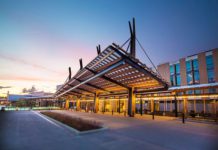WASHINGTON, D.C. – The Department of the Interior announced that the Bureau of Land Management (BLM) has given final approval to the Southern Bighorn Solar Project on tribal lands in Nevada. The Department also announced that construction for the Arrow Canyon Solar Project has begun.
Together, these two key developments for the Moapa Band of Paiutes underscore the Department’s commitment to advancing clean energy projects that will help communities across the country be part of the climate solution while creating good-paying jobs. These two projects will support over 800 jobs and generate enough electricity to power up to 192,000 homes.
“The time for a clean energy future is now – and tribal communities have a significant role to play in the Administration’s ambitious goals,” said Secretary Deb Haaland. “These solar projects will support local tribal economies while adding to the nation’s clean energy supply. The Department is committed to making bold investments that will address the climate crisis, create good-paying jobs, and advance environmental justice.”
Progress on these projects supports the Biden-Harris administration’s goals to permit at least 25 gigawatts of onshore renewable energy by 2025 and to ensure investments in the clean energy economy reach tribal lands. The effort also supports the State of Nevada’s goal to achieve 50 percent renewable energy by 2030.
The Southern Bighorn Solar Project is located in the south central portion of the reservation in Clark County, NV. This project will provide 300 jobs during construction and five permanent jobs when the two facilities included in the project are operational. Once complete, the Southern Bighorn Solar Project will generate enough electricity to power up to 128,000 homes.
The Arrow Canyon Solar Project is located in the southeast corner of the reservation and will generate enough electricity to power up to 64,000 homes. Project construction will provide 500 temporary jobs and then 12 permanent jobs when the facility is operational. The record of decision for the project was signed Jan. 19, 2021. The project is expected to be up and running in December 2022.
The BLM and the Bureau of Indian Affairs lead in permitting the development of the solar arrays and associated transmission lines. Once constructed, the solar arrays, transmission lines and ancillary maintenance roads, distribution lines, and other facilities will connect the solar arrays and battery storage systems to the grid.















































